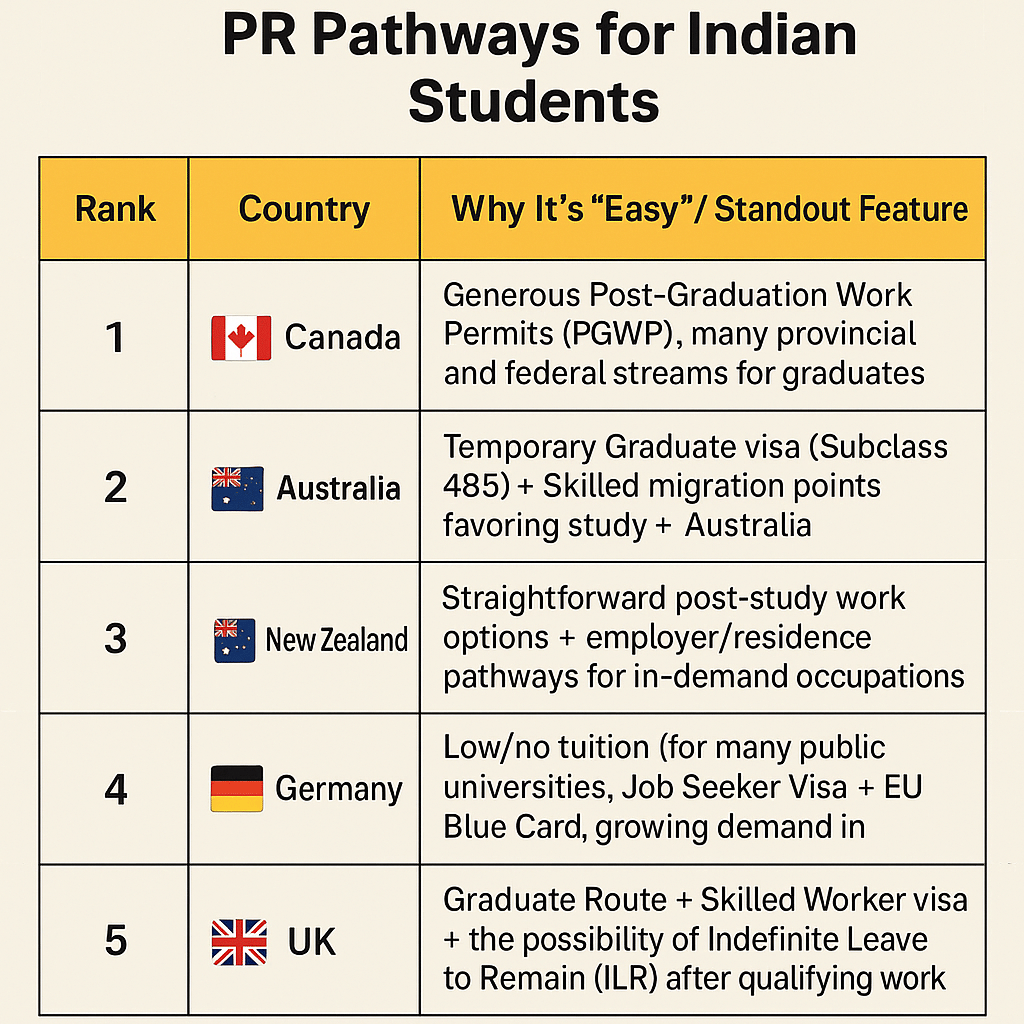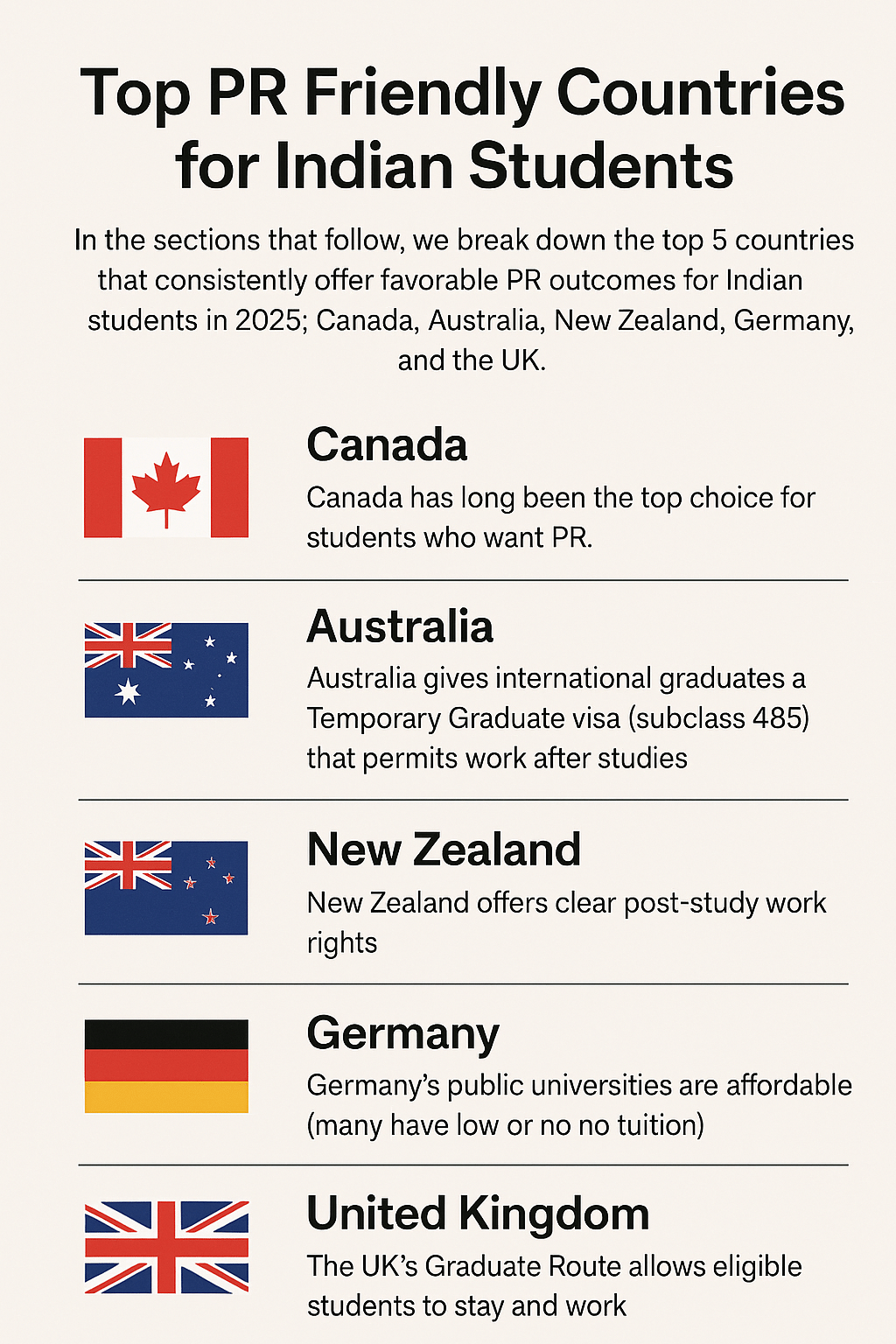Jasmine Grover Content Strategy Manager
Content Strategy Manager | Updated On - Nov 4, 2025
For many Indian students, studying abroad isn’t just about getting a degree—it’s about building a future: gaining work experience, becoming financially independent, and, for many, obtaining Permanent Residency (PR). But not all study abroad destinations lead to a clear “study → work → settle” path. To maximise your chances, you need to choose a country that offers:
- affordable tuition & living costs
- strong post-study work rights
- clear, achievable PR pathways
This guide highlights the top destinations that Indian students are using today to transition from a student visa to PR, with recent data, practical tips, and what to watch out for.
Check Out: Best Countries for Studying Abroad
Top Countries with Easy PR Pathways for Indian Students
| Rank | Country | Why It’s “Easy” / Standout Feature |
|---|---|---|
| 1 | Canada | Generous Post‑Graduation Work Permits (PGWP), many provincial and federal streams for graduates, strong points for local work experience. |
| 2 | Australia | Temporary Graduate visa (Subclass 485) + Skilled migration points favoring study + work in Australia. |
| 3 | New Zealand | Straightforward post‑study work options + employer/residence pathways for in‑demand occupations. |
| 4 | Germany | Low/no tuition (for many public universities), Job Seeker Visa + EU Blue Card, growing demand in STEM & tech. |
| 5 | UK | Graduate Route + Skilled Worker visa + the possibility of Indefinite Leave to Remain (ILR) after qualifying work & stay. |

What Does Easy PR Really Mean for Indian Students?
When we say “easy PR” for Indian students, we don’t mean it’s automatic or guaranteed. No country offers PR without effort. But some countries offer clear, structured pathways from study to permanent residency—especially for international graduates with in-demand skills. Easy PR generally refers to:
- Transparent post-study work options
- Pathways where graduates commonly succeed in gaining PR
- Immigration systems that value local education and work experience
- Government-backed policies with regular intake and published targets
Key Factors That Make a Country PR-Friendly:
- Length and Flexibility of Post-Study Work Permits → More time to gain skilled employment = higher PR chances
- Whether Local Work Experience Counts Toward PR → Countries like Canada and Australia give major points for in-country experience
- Graduate-Friendly PR Systems → Points-based or employer-sponsorship pathways that reward international education
- Processing Transparency & PR Intake Targets → Regular immigration updates, quota announcements, and clear eligibility criteria
Top PR Friendly Countries for Indian Students
In the sections that follow, we break down the top 5 countries that consistently offer favorable PR outcomes for Indian students in 2025: Canada, Australia, New Zealand, Germany, and the UK.
Each offers its own mix of affordability, post-study work rights, and realistic migration routes.

Canada
Canada has long been the top choice for students who want PR. The usual path is study → Post-Graduation Work Permit (PGWP) → gain skilled work experience → apply for PR through Express Entry or provincial programs. The system is explicit: work experience in Canada is heavily weighted in federal points systems, and many provinces run streams specifically for international graduates.
In its 2025–2027 Immigration Levels Plan, Canada reaffirmed its commitment to high immigration targets, including through student-to-PR pathways. This is great news for Indian students aiming to settle long-term.
However, there’s a caution:
Due to a surge in temporary residents and infrastructure pressures, Canada has tightened some aspects of study permit approvals and PGWP eligibility in recent months. IRCC has made policy adjustments to better manage student volumes, and approvals have become more competitive, especially in private institutions.
Bottom line: Canada is still a fantastic PR destination—but Indian students should plan carefully, stay informed, and only choose programs eligible for PGWP.
- 2025 has seen stricter controls on study permits, including a nationwide cap of 437,000 permits (down 10% from 2024), and for the first time, master’s and PhD students are included in this cap.
- Students must submit a Provincial Attestation Letter (PAL), complicating the process for new applicants.
- There is a record-high student visa rejection rate of up to 80% for Indian applicants in 2025 due to stricter financial requirements and documentation standards.
- Private college students are particularly affected by new restrictions on PGWP eligibility.
Provincial Nominee Program allocations have been cut by 50% in 2025, and some provinces have also temporarily limited or suspended certain PNP streams, making PR more competitive and sector-focused
Practical Tip
- Pick a Designated Learning Institution (DLI) that qualifies for the full-length PGWP (up to 3 years).
- Aim for at least 1–2 years of skilled work experience in NOC TEER 0, 1, 2, or 3 jobs after graduation.
- Consider studying in provinces like Ontario, British Columbia, or Alberta, where PNP streams favour international grads.
- Regularly monitor IRCC updates for changes in eligibility, quotas, and PGWP policies.
Australia
Australia gives international graduates a Temporary Graduate visa (subclass 485) that permits work after studies, and its points-based skilled migration pathways reward Australian work experience.
Australia continues to have a substantial population of recent graduates on 485 visas — a stock figure reported in early 2025 showed over 200,000 people holding or in the cohort of Temporary Graduate visas at a recent peak, which reflects how widely the 485 pathway is used. That practical post-study time on the ground remains a critical stepping stone to employer sponsorship or state skilled nomination.
Practical tip: Target occupations in state skilled lists and gain local work experience; many states are more likely to nominate candidates with Australian study and work history.
New Zealand
New Zealand offers clear post-study work rights and has been actively trying to grow quality international education while also maintaining pathways for skilled workers to remain. New Zealand’s Skilled Migrant Category and employer-assisted residence routes can be accessible to graduates in in-demand occupations.
New Zealand has recently announced plans and targets to grow international student numbers and manage transitions to work and residence — part of a policy approach that connects study, talent retention, and immigration planning. For students in health, engineering, IT, and trades, the local labor market often provides meaningful opportunities to move from post-study work to residence.4
Practical tip: If you study in an occupation on the ANZSCO skill lists or get employed by a licensed employer, it’s easier to convert temporary status into residence.
Germany
Germany’s public universities are affordable (many have low or no tuition), and the country offers a Job Seeker Visa as well as the EU Blue Card for highly skilled workers. Graduates of German universities can often find work in IT, engineering, and research — roles that qualify for longer-term residence or EU Blue Card routes.
Germany remains a major destination for Indian students, particularly at the master’s level in engineering and STEM fields. While EU Blue Card issuance to certain nationalities has fluctuated in recent years, Germany’s integration of graduates into the labor market remains strong for in-demand skills.
Practical tip: Learning at least basic German language skills dramatically increases job prospects outside a few English-speaking corporate niches.
United Kingdom
The UK’s Graduate Route allows eligible students to stay and work (typically for two years after a master’s, three years for PhDs), and many graduates switch into Skilled Worker visas, which in turn can lead to settlement (Indefinite Leave to Remain) after a qualifying period.
The UK remains an active destination for international students, and many former students successfully transition from the Graduate Route into sponsored roles and then to settlement. However, policy shifts and periodic reviews of the Graduate Route and skilled worker criteria mean students should keep themselves updated. Government statistics from 2024–2025 show the UK still issues a high volume of student visas, though growth has slowed in some categories.
Practical tip: If aiming for the UK, secure internships and graduate roles with employers who can sponsor Skilled Worker visas.
A few other options worth noting
- Ireland: Offers Stamp 1G for graduates (post-study work) and Critical Skills Employment Permits that can fast-track residency steps. Ireland is a competitive yet attractive destination for STEM and finance graduates.
- The Netherlands, Sweden, and Portugal each offer graduate search permits or skilled worker routes, which can be attractive depending on your field (tech, research, healthcare).
How to choose your Study Abroad Destination for easy PR?
- Check post-study work length: Longer work permits = more time to find skilled employment and build PR points.
- Match your field to demand: Countries favor different skills. IT and healthcare are in high demand in many places; engineering is a strong field in Germany; care and hospitality are essential sectors in the UK and Canada.
- Language and lifestyle: Language matters for daily life and many jobs. Germany and the Netherlands often expect language skills for broader job access.
- Cost and scholarship options: The total cost of living and tuition is a significant factor; Germany and some EU countries may offer lower costs than those in North America or Australia.
- Immigration stability: Monitor official government pages for policy updates and changes. Rules change; pick a country where you can adapt if timelines move.
Realistic timelines and expectations
- Canada & Australia: Many students convert to PR within 2–5 years if they secure the right work experience and meet points or nomination requirements.
- New Zealand & UK: Typically 3–6 years depending on occupation and sponsorship.
- Germany & EU: The time varies; for skilled workers with a job and a Blue Card, 2–4 years is possible, although language and job level are factors.
Final tips for Indian students
- Plan PR early: Choose a study program and city with future job demand in mind. Don’t treat PR as an afterthought.
- Network during study: Internships, part-time employment, and university career services are critical.
- Keep documents organized: Tax records, employment letters, and supervised work references are essential for PR applications.
- Follow official sources: Use government immigration pages and the university international office for the latest rules. Policies can change quickly.
There’s no one-size-fits-all answer when it comes to choosing the best country for PR after study. Your decision should reflect your budget, academic goals, language preferences, long-term career plans, and family considerations.
That said, countries like Canada, Australia, New Zealand, Germany, and the UK continue to stand out in 2025 because they combine quality education with genuine, structured pathways to permanent residency. Thousands of Indian students successfully transition from study to settlement in these destinations each year.
But remember: immigration policies evolve. The landscape has been fast-changing in 2025, with governments adjusting intakes, eligibility, and visa conditions. Always rely on official sources for updates—and have a Plan B in case rules shift mid-way through your journey. Whether your goal is to build a life abroad or simply gain global experience, the key is to plan early, choose wisely, and stay informed.



Comments